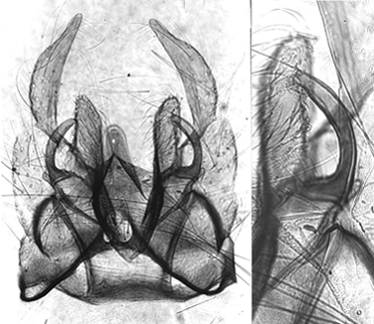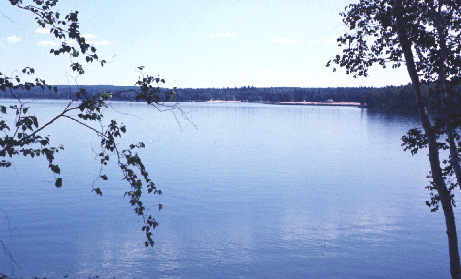Species 2m. C. rempelii Thienemann, 1941.C. hyperboreus - Rempel, 1936, misdetermination of C. hyperboreus Staeger, 1845
Syn. Tendipes anthracinus - Townes, 1945
Possibly a synonym of C. anthracinus Zett., but may be a sibling speciesAdult:
Male: Length about 8 mm. Dark species, thorax black, scutal stripes barely visible, abdominal segments black with grey apical margins; legs black, anterior tarsi bearded.
Wing length about 5.93 mm, width 1.33-1.40 mm; 4 SCf, about 44.7 (43-47) setae on squamal fringe.
Head: AR 5.08-6.16, Frontal tubercles about 46-51 x 18 µm and 2,6-2.9 times longer than wide. Relative proportions of palp segments (micron): 90 : 81 : 312 : 320 345 : P5/P3 about 1.07-1.14; P5/P4 about 1.07-1.08.
Thoracic setae: perhaps 24 acrostichal; 46-57 dorsocentrals; 10-13 prealars; 2 supraalars; 64-66 scutellars with about 25-28 in posterior row and 38-39 in scattered rows anteriorly.
Beard appears to be comprised of both a shorter and a longer set of setae.Male genitalia figured by Rempel (1936), style relatively short, narrowing over the posterior quarter; about 8 setae near middle of 9th tergite, superior volsella closest to the E(i)-type of Strenzke (1959).
Male hypopygium (left) and superior volsella (right) of Chironomus rempelii from Lake Waskesui, Saskatchewan.Female generally resembles male, but legs are paler - dark brown, with proximal half of anterior femur somewhat yellowish.
Female genitalia figured by Rempel (1936)Pupa: Mean length about 12 mm. Late pupa almost black.
Frontal tubercles with a short seta. Lateral setae on Segments II to IV have 3, 4 and 4 short lateral hairs respectively, while segments V to VII have 4 lateral setae and segment VIII has 5.
Shagreen pattern shown in Rempel's figure. Posterolateral spurs on segment VIII with about 8 rather long appressed spines. Fourth instar larva a large bathophilus type, length about 10.5-22.0 mm; ventral tubules about equal length and longer than posterior prolegs. Later studies suggest the larva may be a thummi-type as C. anthracinus, but those populations need to be studied further.
Mentum width 220 µm, with broad c1 tooth, c2 teeth relatively well separated (type I or II); 4th laterals reduced at least to level of 5th laterals (type II), which in Rempel's material project beyond the level of 3rd to 6th laterals. Pecten epipharyngis with 16-18 blunt teeth.
Rempel's figure of the premandible suggests the teeth are about equal length and inner tooth is slightly wider (type B1?).
Mandible with 3rd inner tooth pale.
Antennal segments in ratio 40 : 10 : 3 : 5 : 1 ; Ring organ towards middle of the basal segment. Egg mass: Rempel (1936) figures the egg mass as globular with two transparent threads traversing it. Can be 650 eggs in the mass. Cytology: 4 polytene chromosomes chromosomes with the thummi arm combination AB, CD, EF, G.
Arm G generally unpaired, sometimes cloudlike, sometimes with clear bands and heterochromatin cap in the area of the nucleolus. Nucleolus in arm F, which may be heterozygous in males for one (in region 3-4, F1k) or two (other in region 1, F1kk) heterochromatic bands. This polymorphism may be seen in all males (Waskesiu) or only in a small number (Lake Amisk, Baptist lake).
Most common pattern in all arms as in C. anthracinus.
Polymorphism in arms A, B, C, D and F.
The sequences are given the prefix 'ant' to relate them to the sequences as identified by Kiknadze et al. (2005). antA1: 1a-2c, 10-12a, 13ba, 4a-c, 2g-d, 9-4d, 2h-3, 12cb, 13c-19 i.e. as plumosus A2
antA2: 1-2c, 10-12a, 13ba, 3f-2h, 4d-9e, 2d-g, 4c-a, 3g-i, 12cb, 13c-19 rare
antA3: 1-2c, 9a-e, 2d-g, 4c-a, 13ab, 12a-10, 8a-4d, 2h-3, 12cb, 13c-19 rare
antB1: not mapped.
antB2: Simple inversion near distal end.
antC1: 1-6b, 11c-8, 15-11d, 6gh, 17a-16, 7d-a, 6f-c, 17b-22
antC3: small inversion of region about 17a-6c. rare
antD1: 1-3g, 14g-16, 8c-7g, 5d-7f, 18d-17, 8d-10a, 13a-11, 14f-13b, 10b-e, 4-5c, 18e-24
antD3: 1-3g, 14g-16, 8c-7g, 18a-d, 7f-5d, 17f-a, 8d-10a, 13a-11, 14f-13b, 10b-e, 4-5c, 18e-24 rare
antE1: 1 - 3e, 5 - 10b, 4 - 3f, 10 - 13 i.e as cingulatus, tardus and sp. 3b.
antF1: 1 - 8e, 9c - 23 (with variants F1k and F1kk in males only)
antF3: 1 - 8e, 9c-e, 14 - 10, 15 - 23 rare Found: Alberta - ¿Lake Amisk.
Manitoba - ¿Baptist Lake.
Saskatchewan - Lake Waskesiu, Prince Albert National Park (Type locality).
Wisconsin - ¿Pleasant Lake, Walworth Co. (W. Hilsenhoff). Occurs at depth of 10 m or greater. Life cycle in Lake Waskesiu is two years.
Type locality, Lake Waskesui, Saskatchewan.Morphology of larva, pupa and adult above are based on the descriptions of Rempel (1936) (as C. hyperboreus). Townes 1945 considered the adult was C. anthracinus Zett., but Thienemann (1954) still regarded it as a separate species. The karyotype shows relationship to that of C. anthracinus such that Shobanov et al. (1996) and Kiknadze, et al. (2005) have also considered it to be a synonym of C. anthracinus. This may well be correct, but there are some aspects that still suggest that it may be a separate subspecies or sibling species: The heterochromatin on arm F and the sequences A3, C3 and F3 have so far only been found in certain Canadian samples, and the location of the MD has not been determined in any typical C. anthracinus populations. The larva described by Rempel (see above) is shown as a bathophilus-type larvae, whereas the true C. anthracinus has a thummi-type larva.
Karyotype pictured by Rempel et al. (1962) and in more detail by Kiknadze et al. (2005).
The molecular results of Isabelle Proulx on Canadian lakes indicate that there is a close relative of C. anthracinus, which may be C. rempelii, although this cannot be proven in the absence of material from the type locality. This material also has a thummi-type larva (see C. sp. NAI), so may be further member of this anthracinus-group of species. See also C. anthracinus, C. hyperboreus and C. sp. u[ Return to Index| Go to References ] |

